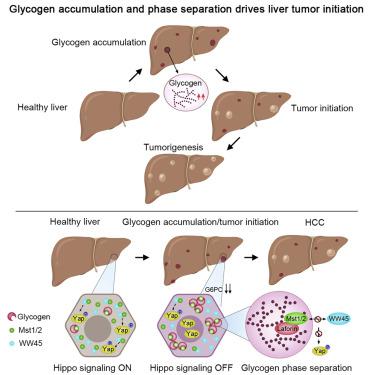Cell ( IF 45.5 ) Pub Date : 2021-10-21 , DOI: 10.1016/j.cell.2021.10.001 Qingxu Liu 1 , Jiaxin Li 1 , Weiji Zhang 1 , Chen Xiao 1 , Shihao Zhang 1 , Cheng Nian 1 , Junhong Li 1 , Dongxue Su 1 , Lihong Chen 2 , Qian Zhao 3 , Hui Shao 4 , Hao Zhao 1 , Qinghua Chen 1 , Yuxi Li 1 , Jing Geng 1 , Lixin Hong 1 , Shuhai Lin 1 , Qiao Wu 1 , Xianming Deng 1 , Rongqin Ke 4 , Jin Ding 3 , Randy L Johnson 5 , Xiaolong Liu 6 , Lanfen Chen 1 , Dawang Zhou 1

|
Glucose consumption is generally increased in tumor cells to support tumor growth. Interestingly, we report that glycogen accumulation is a key initiating oncogenic event during liver malignant transformation. We found that glucose-6-phosphatase (G6PC) catalyzing the last step of glycogenolysis is frequently downregulated to augment glucose storage in pre-malignant cells. Accumulated glycogen undergoes liquid-liquid phase separation, which results in the assembly of the Laforin-Mst1/2 complex and consequently sequesters Hippo kinases Mst1/2 in glycogen liquid droplets to relieve their inhibition on Yap. Moreover, G6PC or another glycogenolysis enzyme-liver glycogen phosphorylase (PYGL) deficiency in both human and mice results in glycogen storage disease along with liver enlargement and tumorigenesis in a Yap-dependent manner. Consistently, elimination of glycogen accumulation abrogates liver growth and cancer incidence, whereas increasing glycogen storage accelerates tumorigenesis. Thus, we concluded that cancer-initiating cells adapt a glycogen storing mode, which blocks Hippo signaling through glycogen phase separation to augment tumor incidence.
中文翻译:

糖原积累和相分离驱动肝脏肿瘤发生
肿瘤细胞中的葡萄糖消耗通常会增加以支持肿瘤生长。有趣的是,我们报告糖原积累是肝脏恶性转化过程中关键的致癌事件。我们发现,催化糖原分解最后一步的葡萄糖-6-磷酸酶(G6PC)经常被下调,以增加癌前细胞中的葡萄糖储存。积累的糖原经历液-液相分离,导致 Laforin-Mst1/2 复合物组装,从而将 Hippo 激酶 Mst1/2 隔离在糖原液滴中,以减轻其对 Yap 的抑制。此外,人类和小鼠中的 G6PC 或另一种糖原分解酶 - 肝糖原磷酸化酶 (PYGL) 缺陷会导致糖原累积病,并以 Yap 依赖性方式导致肝脏肿大和肿瘤发生。一致地,消除糖原积累会消除肝脏生长和癌症发病率,而增加糖原储存会加速肿瘤发生。因此,我们得出结论,癌症起始细胞采用糖原储存模式,通过糖原相分离阻断 Hippo 信号传导,从而增加肿瘤发生率。











































 京公网安备 11010802027423号
京公网安备 11010802027423号